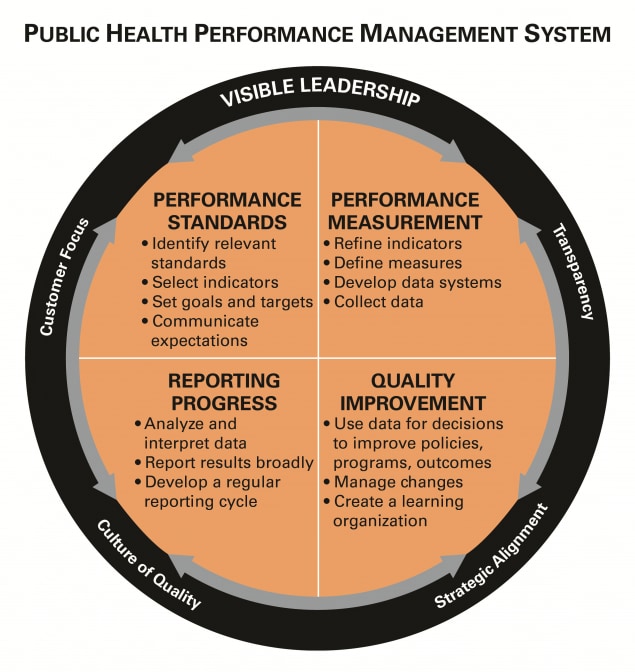At a glance
Explore key milestones and initiatives that have advanced awareness and use of performance management and quality improvement in public health.

The Public Health Improvement Journey
Throughout the years, many initiatives have driven the use of performance management and quality improvement (PM/QI) in public health. The list below, while not comprehensive, highlights key milestones and programs.
Initiatives and resources
The Institute of Medicine, now renamed the Health and Medicine Division of the National Academies of Sciences, Engineering, and Medicine, has provided leadership and national guidance throughout the decades—including the 1988 report that established the core functions of public health, the 1996 report about community health improvement, the 2003 report that included recommendations for catalyzing accreditation and increasing system partnerships, and the 2010 report providing recommendations on performance measurement.
This framework, established in 1994 and updated in 2020, outlines essential areas of public health responsibility. It has set the stage for much of the subsequent work in standards and performance management.
The National Public Health Performance Standards (NPHPS) provide a framework to assess capacity and performance of public health systems and public health governing bodies. The national performance standards, which are based on the Essential Public Health Services framework, have been used in many jurisdictions for public health system building.
The Turning Point Performance Management Excellence Collaborative was a group of seven states and five national partner organizations that studied and promoted the use of performance management systems in public health. The initiative developed a package of resource materials to help public health systems manage performance.
CDC, in partnership with the Robert Wood Johnson Foundation, supported the implementation of a national voluntary accreditation program for state, tribal, local, and territorial health departments. The Public Health Accreditation Board (PHAB), a nonprofit 501(c)3 entity, serves as the independent accrediting body. PHAB led the development and testing activities, with significant participation from local, tribal, state, and national leaders and launched the national accreditation program in 2011. PHAB began accrediting health departments in 2013 and has since launched additional programs like the Pathways Recognition Program and the Vital Records and Health Statistics (VRHS) Accreditation Program.
The US Department of Health and Human Services has led a series of efforts focused on improving quality in public health and health care. Through this effort, a 2008 Consensus Statement on Quality in the Public Health System and a 2010 report describing Priority Areas for Improvement of Quality in Public Health.
The National Public Health Improvement Initiative (NPHII) was an innovative program started by CDC to infuse quality and performance improvement methods into health departments across the country from 2010-2014. Learn more about NPHII's accomplishments and read a compendium describing its accomplishments, including 71 stories from state, tribal, local, and territorial health departments.
Assessment Protocol for Excellence in Public Health (APEX/PH): In 1991, CDC and the National Association of County and City Health Officials (NACCHO) released APEX/PH to provide local health departments with guidance for conducting an organizational capacity assessment and a community health assessment. The history of current tools, like Mobilizing for Action through Planning and Partnerships (MAPP) is rooted in APEX/PH.
Multi-State Learning Collaborative (MLC): This Robert Wood Johnson Foundation-funded initiative was put in place in 2005. This effort paralleled development of a national accreditation program and brought together states implementing agency performance and capacity assessment, accreditation programs, and quality improvement initiatives to improve the public health knowledge base.
In addition to the initiatives noted above, considerable work has focused on disciplinary or programmatic areas. The Laboratory System Improvement Program and the Environmental Public Health Performance Standards are just two examples of how we can link with and learn from more focused efforts.
Finally, experiences and resources from sectors outside of public health such as industry, business, health care, and education have provided a foundation for many of these initiatives. Links to sites featuring some of this work can be found on the resources page.
